0
-
An empty cart
You have no item in your shopping cart
envato-wordpress-toolkit domain was triggered too early. This is usually an indicator for some code in the plugin or theme running too early. Translations should be loaded at the init action or later. Please see Debugging in WordPress for more information. (This message was added in version 6.7.0.) in /var/www/wp-includes/functions.php on line 6121g5plus-darna domain was triggered too early. This is usually an indicator for some code in the plugin or theme running too early. Translations should be loaded at the init action or later. Please see Debugging in WordPress for more information. (This message was added in version 6.7.0.) in /var/www/wp-includes/functions.php on line 6121The choice of the most suitable method of cake discharge for a particular RVDF application depends not only on the nature of the cake, but also on considerations of protection of the main filter medium from wear. The cake can vary in consistency, thickness and structure according to the products being handled, from a pastelike substance to a consistent solid.
The scraper discharge ( Figure 3.17 ) is widely used for effluent sludge, in mineral ore dressing or metallurgical working, for chemical process slurries, and similar products. The cake is carried about three-quarters of the way around the drum, to encounter a flat blade (doctor blade) usually stretching across the full width of the drum. The scraper blade itself may be fixed or self-adjusting. A fixed blade with high pressure blow-back at that point is more or less traditional in certain applications (such as coal slurry dewatering, metallurgical processing and so on). The blade is actually set at a small distance away from the surface of the drum, the actual separation of the cake being achieved by blow-back pressure, which lifts the medium briefly away from its supports, and the scraper thus merely guides the cake away from the drum.
A fixed blade may also be used without blow-back. In this case, the blade is set to skim a certain thickness of the cake, leaving the rest as a heel on the drum
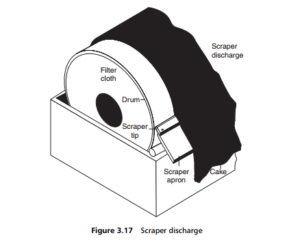
surface. This has the advantage of providing a drier discharged cake as well as subjecting the cloth to minimal wear. It is used particularly with crystalline solids and certain types of metallurgical sludges and for discharge from a precoat filter. In the latter case, the blade is set to remove all of the cake thickness plus a small thickness of precoat.
Self-adjusting scraper blades provide a better performance on thin filter cakes that crack readily. Here flexible plastic or spring-loaded blades are used, and the filter cloth is caulked, so that under a low pressure air blow-back it balloons outwards
against the blades so that the blade and cloth remain in light, close contact. With a proper technique cloth wear is minimized in this way.
A scraper discharge belt filter is shown in Figure 3.18, which also features wash rolls in the 10 o ’ clock to 1 o’ clock positions of the drum’ s rotation.
Roller discharge ( Figure 3.19 ) is limited to cakes of an adhesive nature, which will transfer from the main filter cloth to a separate roller. The cake is then released from the roller by a scraper blade, which can be in close contact with the roller
without causing cloth wear problems. In effect this is a form of scraper discharge, but eliminating any contact between the scraper blade and the cloth. The proper discharge of cake from a rotary drum vacuum filter is of paramount importance if
this type of filter is to continue working efficiently.
The two previous methods of cake discharge have both been directly from the drum. The other methods involve the lifting of the cake off the drum and taking it
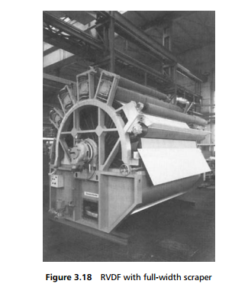
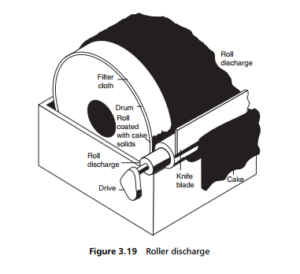
to a separate roller at which it can more easily be released. A string discharge filter ( Figure 3.20 ) has a number of endless strings, spaced at about 10–12 mm pitch over the width of the filter drum, the run of these strings being extended to form an open conveyor system passing over separate discharge and return rollers. Effectively, these strings lift the cake off the filter cloth at the point where they leave the drum tangentially, the cake then falls off the strings as they loop back around the discharge roll. A guide comb may also be incorporated between the discharge and return rolls, to retain string alignment and remove any residual cake adhering to the strings.
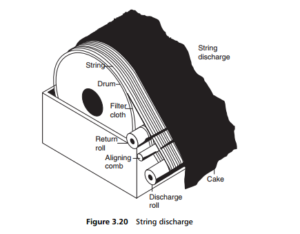
String discharge minimizes mechanical wear on the filter cloth (enabling thinner cloths to be used), avoids the need for blow-back and provides continuous steady discharge at any suitable point away from the drum. The strings are normally made of synthetic fibres (e.g. nylon, polyester or polypropylene), chosen according to the product being handled. They can also be in the same material as the cloth, or in specific cases in the form of metal wire springs rather than individual strings.
Belt discharge (Figure 3.21) is similar to string discharge in operating principle, in that the cake is carried away from the drum to the discharge point, except that in this case the cloth itself is led off the drum over rollers of a smaller diameter
to form a conveyor run, with the cake automatically tumbling off the cloth at the extremity of the run. The return run of the cloth then passes through a washing device, to clean it before it returns to the feed trough.
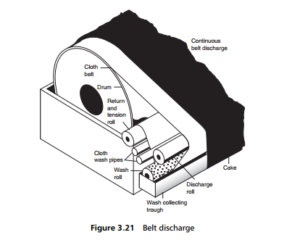
This method provides complete support of the cake to the point of discharge and thus is capable of handling all types of cakes and cake thicknesses. It does not need blow-back and mechanical wear on the cloth is minimal. The washing on the return
run also eliminates any tendency for the cloth to become clogged.
In the dewatering of flotation concentrate slurries, produced during mineral dressing operations, and in similar processes, the objectives are to recover the maximum amount of solids, produce saleable products where possible, and thus increase
plant capacity at the most economic cost. There has been a significant improvement in process efficiency in this application by the use of belt discharge drum filters in place of disc vacuum filters and string/scraper drums.
The success of the belt-type drum filter is based on the simple premise that, if filter cakes can be removed completely and continuously from a vacuum filter, this must then give the best possible conditions for high capacity and good cake drying. To achieve this, the filter media must be kept in a clean condition and the discharge system must not rely on a high mechanical strength in the filter cakes. These requirements can be met completely by a belt discharge system. On this type of
filter, the filter cake is positively supported on the filter medium, which acts as a conveyor carrying the cake from the filter drum to the discharge point. The filter medium, after removal of the filter cake, can be washed to maintain it in a clean
state before it returns to the drum.
Belt discharge rotary drum filters can give throughputs of up to 30% higher than those previously given by rotary drum filters fitted with knives or string discharge. Even more dramatic improvements are being achieved as compared with the rotary disc filters previously used, where past experience has shown that this type are prone to poor discharge and filter cloth binding. Where this occurred, 50% or more of the cake often fell back into the feed trough, causing a decreased throughput. Appreciably lower moisture contents in the filter cakes are also obtained. This can give significant reductions in costs for subsequent drying and in some cases it allows the drier filter cake to be handled on conveyors, and blended with other material as a saleable product without difficulty.
Belt discharge filters also give much greater capability to deal with variations in the filter feed material and this is of particular importance when the filter is handling a natural material or effluent, in which appreciable variations can occur. Belt discharge filters are now widely used in coal washing and preparation plants, where units in operation are generally large, having areas of 55 to 75 m2.
To ensure optimum performance of the filter, it is critical that the belts be trouble free in operation. It is important that the belt lies flat on the drum (it must not fold or crease) and the filter medium, in addition to having the right filtration
characteristics, must also have the correct mechanical characteristics. The whole system (drum, discharge rolls, wash roll) must be constructed to a high degree of accuracy.
In general the life of the filter (i.e. the filter cloth) is in the range of six to twelve months, although cases of eighteen months are known. This contrasts with other types of vacuum filter where cloth life can be only three to four months. Key points
to be considered in the design of belt discharge vacuum filters are:
1. accuracy in the fabrication of the filter drum
2. specially designed internal drain lines to minimize filtrate velocities, minimize wear and ease of maintenance
3. accurately manufactured discharge rolls mounted in self-aligning bearings with only one roll arranged for adjustment
4. simple and effective tracking system and belt tensioning system on one roll
5. heavy duty sloping collection trough for belt washings
6. availability of additional discharge roll for extra heavy duty
7. a facility to use an air knife not in contact with the belt to remove difficult cakes
8. availability of full width weir overflow on the filter trough to handle heavily frothed materials effectively and prevent spillage
9. standard fitting of wide range, heavy duty, variable speed, drum drive gearbox for maximum flexibility and service
10. availability of the manufacturer ’ s total backup services at all stages of design, construction, commissioning and operation of the plant, to inshore optimum performance of the filter and the complete system.